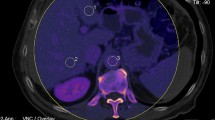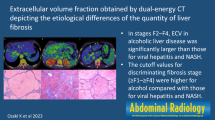Abstract
Objective
Fractional extracellular space has been validated as a marker of hepatic fibrotic in cirrhotic patients at CT-scan as well as on dual-energy CT, which takes advantage from iodine uptake. Since no consensus still exists between equilibrium phases performed at 3 or 10 min, the first aim of this work is to evaluate performances at the two different time points. Moreover, correlation between fractional extracellular space and oesophageal varices, directly related to liver fibrosis, has been assessed.
Materials and methods
Dual-Energy equilibrium phases at 3 and 10 min were performed within a follow-up CT-protocol scan in cirrhotic patients. Oesophageal varices were endoscopically assessed according to their size. At the two different time points, correlation between iodine density of the right and left liver lobes and correlation between the fractional extracellular space values were assessed. Correlation between fractional extracellular space and endoscopic grade of oesophageal varices was calculated.
Results
No statistical differences were found between the iodine density values from the two liver lobes at the two time points (p = 0.8 at 3′; p = 0.5 at 10′). No statistical difference about fractional extracellular space estimation was found between the two time points (p = 0.17). Correlation between fractional extracellular space values and oesophageal varices was moderate (ρ = 0.45, IC 0.08–0.71, p < 0.05).
Conclusion
Fractional extracellular space assessed on dual-energy CT at equilibrium phases with different timing was substantially similar. The moderate correlation found between fractional extracellular space and endoscopic grade of oesophageal varices confirms that CT-scan is not currently reliable as endoscopy.




Similar content being viewed by others
References
Pinzani M, Rombouts K (2004) Liver fibrosis: from the bench to clinical targets. Dig Liver Dis 36:231–242. https://doi.org/10.1016/j.dld.2004.01.003
Friedman SL (2003) Liver fibrosis—from bench to bedside. J Hepatol 38:38–53. https://doi.org/10.1016/S0168-8278(02)00429-4
Varenika V, Fu Y, Maher JJ et al (2013) Hepatic fibrosis: evaluation with semiquantitative contrast-enhanced CT. Radiology 266:151–158. https://doi.org/10.1148/radiol.12112452
Villeneuve JP, Dagenais M, Huet PM et al (1996) The hepatic microcirculation in the isolated perfused human liver. Hepatol Baltim Md 23:24–31. https://doi.org/10.1002/hep.510230104
Sahin S, Rowland M (2000) Estimation of aqueous distributional spaces in the dual perfused rat liver. J Physiol 528:199–207. https://doi.org/10.1111/j.1469-7793.2000.00199.x
Zissen MH, Wang ZJ, Yee J et al (2013) Contrast-enhanced CT quantification of the hepatic fractional extracellular space: correlation with diffuse liver disease severity. AJR 201:1204–1210. https://doi.org/10.2214/AJR.12.10039
Bandula S, Punwani S, Rosenberg WM et al (2015) Equilibrium contrast-enhanced CT imaging to evaluate hepatic fibrosis: initial validation by comparison with histopathologic sampling. Radiology 275:136–143. https://doi.org/10.1148/radiol.14141435
Yoon JH, Lee JM, Klotz E et al (2015) Estimation of hepatic extracellular volume fraction using multiphasic liver computed tomography for hepatic fibrosis grading. Invest Radiol 50:290–296. https://doi.org/10.1097/RLI.0000000000000123
Guo SL, Su LN, Zhai YN et al (2017) The clinical value of hepatic extracellular volume fraction using routine multiphasic contrast-enhanced liver CT for staging liver fibrosis. Clin Radiol 72:242–246. https://doi.org/10.1016/j.crad.2016.10.003
Ascenti G, Sofia C, Mazziotti S et al (2016) Dual-energy CT with iodine quantification in distinguishing between bland and neoplastic portal vein thrombosis in patients with hepatocellular carcinoma. Clin Radiol 71:938.e1-938.e9. https://doi.org/10.1016/j.crad.2016.05.002
Ascenti G, Mileto A, Krauss B et al (2013) Distinguishing enhancing from nonenhancing renal masses with dual-source dual-energy CT: iodine quantification versus standard enhancement measurements. Eur Radiol 23:2288–2295. https://doi.org/10.1007/s00330-013-2811-4
Ascenti G, Mazziotti S, Mileto A et al (2012) Dual-source dual-energy CT evaluation of complex cystic renal masses. Am J Roentgenol 199:1026–1034. https://doi.org/10.2214/AJR.11.7711
Marino MA, Silipigni S, Barbaro U et al (2017) Dual energy CT scanning in evaluation of the urinary tract. Curr Radiol Rep 5:46. https://doi.org/10.1007/s40134-017-0243-7
Sofue K, Tsurusaki M, Mileto A et al (2018) Dual-energy computed tomography for non-invasive staging of liver fibrosis: accuracy of iodine density measurements from contrast-enhanced data: staging of liver fibrosis in dual-energy CT. Hepatol Res. https://doi.org/10.1111/hepr.13205
Bottari A, Silipigni S, Carerj ML et al (2019) Dual-source dual-energy CT in the evaluation of hepatic fractional extracellular space in cirrhosis. Radiol Med. https://doi.org/10.1007/s11547-019-01089-7
Tsoris A, Marlar CA (2019) Use of the Child Pugh score in liver disease. In: StatPearls. StatPearls Publishing, Treasure Island (FL)
Hashizume M, Kitano S, Yamaga H et al (1990) Endoscopic classification of gastric varices. Gastrointest Endosc 36:276–280. https://doi.org/10.1016/S0016-5107(90)71023-1
Abby Philips C, Sahney A (2016) Oesophageal and gastric varices: historical aspects, classification and grading: everything in one place. Gastroenterol Rep 4:186–195
de Oliveira AC (2017) Short article: noninvasive assessment of portal hypertension and detection of esophageal varices in cirrhosis. Eur J Gastroenterol Hepatol 29:531–534. https://doi.org/10.1097/MEG.0000000000000830
Garcia-Tsao G (2004) Portal hypertension. Curr Opin Gastroenterol 20:254–263. https://doi.org/10.1097/00001574-200405000-00010
Reiberger T, Ferlitsch A, Payer BA et al (2012) Non-selective β-blockers improve the correlation of liver stiffness and portal pressure in advanced cirrhosis. J Gastroenterol 47:561–568. https://doi.org/10.1007/s00535-011-0517-4
Bauer RW, Kramer S, Renker M et al (2011) Dose and image quality at CT pulmonary angiography—comparison of first and second generation dual-energy CT and 64-slice CT. Eur Radiol 21:2139–2147. https://doi.org/10.1007/s00330-011-2162-y
Marin D, Ramirez-Giraldo JC, Gupta S et al (2016) Effect of a noise-optimized second-generation monoenergetic algorithm on image and conspicuity of hypervascular liver tumors: an in vitro and in vivo study. Am J Roentgenol 206:1222–1232. https://doi.org/10.2214/AJR.15.15512
Berzigotti A, Bosch J (2018) Diagnostic methods for cirrhosis and portal hypertension. Springer International Publishing, Cham
Author information
Authors and Affiliations
Corresponding author
Ethics declarations
Conflict of interest
The authors declare that they have no conflict of interest.
Ethical statement
This work was in accordance with the ethical standards of the institutional and/or national research committee and with the 1964 Helsinki Declaration and its later amendments or comparable ethical standards.
Informed consent
Informed consent was obtained from all individual participants involved in the study.
Additional information
Publisher's Note
Springer Nature remains neutral with regard to jurisdictional claims in published maps and institutional affiliations.
Rights and permissions
About this article
Cite this article
Cicero, G., Mazziotti, S., Silipigni, S. et al. Dual-energy CT quantification of fractional extracellular space in cirrhotic patients: comparison between early and delayed equilibrium phases and correlation with oesophageal varices. Radiol med 126, 761–767 (2021). https://doi.org/10.1007/s11547-021-01341-z
Received:
Accepted:
Published:
Issue Date:
DOI: https://doi.org/10.1007/s11547-021-01341-z




